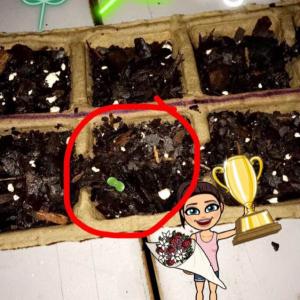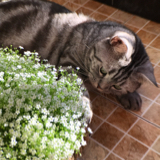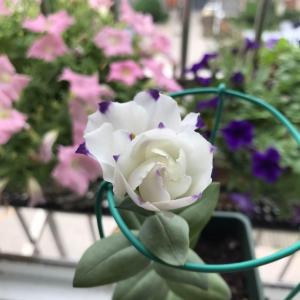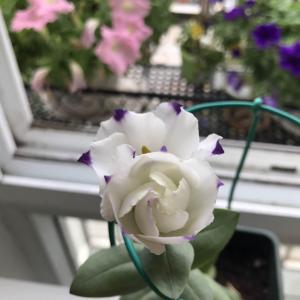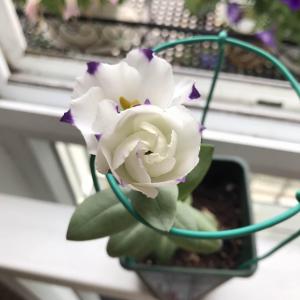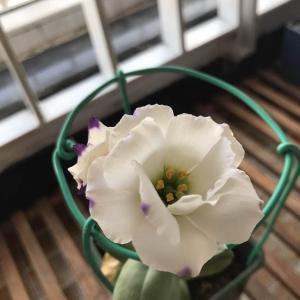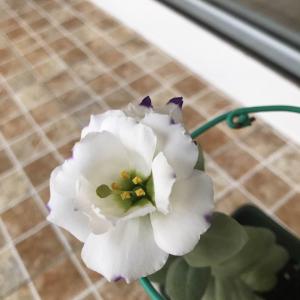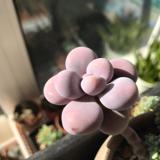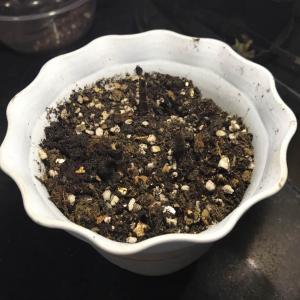文章
玲儿
2017年08月06日

セリンセ・マヨールの基本情報
学名:Cerinthe major
科名 / 属名:ムラサキ科 / セリンセ属
特徴
セリンセ・マヨールは、ロウ質の光沢をもつ筒状の花をつける一年草です。ヨーロッパでは4種が栽培されていますが、マヨルはその代表種で、筒状部は長さ3cmほど、先は開いて5枚の花弁に分かれます。基本種の花色は黄色と暗紫色の2色ですが、全体が暗紫色になる‘プルプラスケンス’も流通しています。

育て方のポイント
栽培のポイント
よく日が当たる場所に置き、鉢土の表面が乾いたら水やりします。

タネから育てる場合は、10月上旬に腐植質に富んだ水はけのよい用土にタネをまきます。乾きに弱いので、寒風を避けて冬越しさせ、3月下旬に元肥を施して定植します。花がら摘みをまめに行うと長く楽しめます。数株はそのまま育てて採種するようにします。

学名:Cerinthe major
科名 / 属名:ムラサキ科 / セリンセ属
特徴
セリンセ・マヨールは、ロウ質の光沢をもつ筒状の花をつける一年草です。ヨーロッパでは4種が栽培されていますが、マヨルはその代表種で、筒状部は長さ3cmほど、先は開いて5枚の花弁に分かれます。基本種の花色は黄色と暗紫色の2色ですが、全体が暗紫色になる‘プルプラスケンス’も流通しています。

育て方のポイント
栽培のポイント
よく日が当たる場所に置き、鉢土の表面が乾いたら水やりします。

タネから育てる場合は、10月上旬に腐植質に富んだ水はけのよい用土にタネをまきます。乾きに弱いので、寒風を避けて冬越しさせ、3月下旬に元肥を施して定植します。花がら摘みをまめに行うと長く楽しめます。数株はそのまま育てて採種するようにします。

0
0
文章
Miss Chen
2017年08月06日


Description: This perennial wildflower is up to 1' tall and sprawls across the ground, producing several vine-like stems up to 4' long from a central taproot. These angular stems are light green to dull reddish purple and covered with spreading white hairs. The alternate leaves are up to 4" long, 4" across, and more or less orbicular in outline; they are palmate, usually with 5 major lobes that are cleft (sharply divided), as well as some secondary lobes and margins with coarse teeth. The leaves have hairy petioles that can easily exceed 4" in length. A pair of conspicuous green stipules are located at the base of each petiole. Each stipule has a shape that is half-ovate.
From the axils of the leaves, individual flowers develop from pedicels up to 6" long. The flowers are about 1½–2½" across, consisting of 5 broad magenta petals, a columnar reproductive structure, and a whitish green to reddish green calyx. At maturity, the columnar structure expands outward slightly, revealing numerous white stamens and pinkish style-branches. The petals often become white near the center of the flower. The calyx is divided into 5 lanceolate lobes that have light-colored ridges and are quite hairy; these lobes are shorter than the petals. Underneath the calyx, there are 3 floral bracts that are similar in appearance to the calyx lobes. The blooming period occurs from late spring to late summer and lasts about 1-2½ months. There is no noticeable floral scent. The flowers are replaced by carpels that are arranged together like a ring. These carpels are flattened and reniform (kidney-shaped) with short hairy beaks. The flattened sides of the carpels are reticulated, rather than smooth. Each carpel contains a single seed. This wildflower spreads by reseeding itself.
Cultivation: The preference is full sun and mesic to dry conditions. In Illinois, this plant often grows in poor soil that contains sand, gravel, or clay. In rich cultivated soil, it will become longer than it normally does in the wild. After mid-summer, this plant gradually withers away.
Range & Habitat: This non-native wildflower has naturalized in only a few scattered counties in the northern two-thirds of Illinois (see Distribution Map), where it is uncommon. It is adventive from areas further to the west or southwest of the state. Habitats include dry prairies, areas along railroads and roadsides, and abandoned fields. In these habitats, the ground vegetation is relatively low and sparse. In Illinois, Purple Poppy Mallow is often planted in flower gardens because of its attractive flowers.
Faunal Associations: The flowers are cross-pollinated primarily by bees. The caterpillars of Pyrgus communis (Checkered Skipper) sometimes feed on Callirhoe spp. (Poppy Mallows). The foliage is readily consumed by mammalian herbivores, including groundhogs, deer, rabbits, and livestock. This could make the survival of local populations of this plant difficult where there is a preponderance of such animals. The taproot is edible and can be used as emergency food by humans, which means that it is probably edible to pocket gophers and other small rodents as well.
Photographic Location: A flower garden in Urbana, Illinois.
Comments: Purple Poppy Mallow has attractive foliage and very showy flowers that bloom for a fairly long period of time. It can be distinguished from other Callirhoe spp. in Illinois by the shape of its leaves, sprawling hairy stems, and the color of its flowers. For example, Callirhoe alceoides (Pink Poppy Mallow) has smaller flowers that are pink, rather than magenta. Another species, Callirhoe triangulata (Clustered Poppy Mallow), has leaves with a more triangular shape. A third species that is occasionally found within the state, Callirhoe digitata (Fringed Poppy Mallow), has a more erect habit with hairless stems and leaves. It is also useful to examine the carpels: While the flattened sides of the carpels of Purple Poppy Mallow have a reticulated surface, the sides of the carpels of other species in this genus are often smooth.

2
0
文章
Miss Chen
2017年08月06日


Description: This herbaceous perennial plant is 2-4' tall, branching occasionally. It forms a rosette of basal leaves, which usually wither away prior to the blooming period. These basal leaves may be triangular-cordate or palmately lobed. The slender stems are usually glabrous and glaucous; the lower central stem is often terete (furrowed along all sides), while the upper stems are round in circumference. The alternate leaves are up to 5" long and 6" across (excluding their petioles), becoming smaller as they ascend the stems. Each of these leaves is deeply divided into palmate lobes, which are often deeply divided into secondary lobes. The leaves are usually glabrous and glaucous like the stems; their petioles are up to 6" long. The upper stems terminate in one or more flowers on long peduncles (flowering stalks). Each flower is 1-2" across, consisting of 5 magenta petals, 5 green sepals, and a central column of stamens and styles. The outer edge of each petal is slightly fringed and truncate, while the sepals are triangular-ovate with pointed tips. There are no floral bracts underneath the sepals. The blooming period occurs during the summer and lasts about 2 months. There is no floral scent. Each flower matures into a whorl of flattened seeds. Each seed is rectangular, reticulated and pitted along the sides, with little or no pubescence. The root system consists of a woody taproot that is often swollen at the base. This plant spreads by reseeding itself.
Cultivation: The preference is full sun and mesic to dry conditions. Poor soil containing sand, gravel, or clay is preferred, as this reduces competition from neighboring plants. This plant has a tendency to lean over while in bloom, especially if the soil is too moist and rich.
Range & Habitat: The Fringed Poppy Mallow is an uncommon plant that has naturalized in only two or three counties in Illinois (Peoria and Dupage). The webmaster has observed this species at a prairie restoration in Champaign County (see Distribution Map). The Fringed Poppy Mallow is native to the southern Great Plains, where it is more common. Habitats include upland areas of sand prairies, gravel prairies, savannas with scant ground vegetation, and abandoned fields. This species may appear unexpectedly in a prairie restoration as a result of contaminated seed. In Illinois, it is not aggressive.
Faunal Associations: Bees are probably the most important visitors of the flowers. Deer, rabbits, and other mammalian herbivores eat the foliage of Poppy Mallows readily. Rabbits often eat the lower leaves of the Fringed Poppy Mallow (including the lower leaves of the photographed plant), while deer occasionally chomp off the upper half of the foliage.
Photographic Location: A restored prairie at Meadowbrook Park in Urbana, Illinois.
Comments: Among the few Callirhoe spp. (Poppy Mallows) that occur in Illinois, the Fringed Poppy Mallow is the tallest. It is a lanky plant with slender stems and finger-like foliage. Some Callirhoe spp. have floral bracts underneath the sepals of each flower; these floral bracts have a leafy or papery-membranous appearance. However, the Fringed Poppy Mallow lacks such bracts. It is also rather distinctive because of the fringed outer edge of its petals, which becomes more pronounced as the flowers mature. Other Poppy Mallows have flowers with unfringed petals.
0
0
文章
Miss Chen
2017年08月06日


Description: This is an unbranched perennial plant about 1-2' tall. Side stems may develop from upper leaf axils if the central stem is damaged. This stout central stem is 4-angled and it is covered with short white hairs that are usually appressed. The opposite leaves are up to 3½" long and 1½" across. They are broadly oblong to lanceolate in shape, and have smooth, slightly ciliate margins. The lower leaves have short stout petioles, while the upper leaves are sessile. They have deep pinnate venation and are covered with a white pubescence. The upper half of the central stem is perforated by whorled clusters of flowers. Each cluster of flowers is about 2-3" across and in the shape of a flattened sphere, with the flowers arranged in circular rows. The flowers are white, light pink, or lavender, and individually slightly less than ½" long. There are two prominent lips, with small purple spots on the lower one, and fine hairs in the back. The blooming period occurs during early summer and lasts about a month. Neither the flowers nor the leaves have a noticeable scent. The root system consists of a taproot, which forms offshoots occasionally by means of short rhizomes. The seeds are quite small, and distributed by the wind to some extent.
Cultivation: The preference is full or partial sun, and mesic to dry conditions. The soil can contain significant amounts of loam, clay, or gravel; limestone and a high pH are tolerated. The foliage can be affected by the usual diseases that attack other mints, and often appear rather ragged by mid-summer. This plant has greater tolerance to drought than most other members of Mint family.
Range & Habitat: Downy Wood Mint occurs occasionally in scattered counties in Illinois – it has been reported most often from counties in the NE and west-central areas of the state (see Distribution Map). This plant is native to Illinois. Habitats include mesic to dry black soil prairies, dolomite prairies, thickets, savannas, limestone bluffs, and limestone glades.
Faunal Associations: The flowers attract long-tongued and short-tongued bees, bee flies, Syrphid flies, butterflies, and skippers. The numerous bee visitors include honeybees, bumblebees, Anthophorine bees, little carpenter bees, leaf-cutting bees, Halictine bees, masked bees, and others. The small seeds are unlikely to be of much interest to birds, nor is the foliage an attractive source of food to mammalian herbivores.
Photographic Location: The photographs were taken at Loda Cemetery Prairie in Iroquois County, Illinois.
Comments: This plant can be easily confused with some of the weedier Eurasian mints, but should not be destroyed because it is not particularly common in Illinois. Notwithstanding its common name, Downy Wood Mint occurs in open areas more often than woodlands, unlike other members of the genus, such as Blephilia hirsuta (Hairy Wood Mint). The stems of the latter species have long spreading hairs, while the stems of Downy Wood Mint usually have short appressed hairs. Other common names for Blephilia ciliata are 'Ohio Horsemint' and 'Pagoda Plant.'
0
0
文章
Miss Chen
2017年08月06日


Description: This perennial herbaceous plant is 2½–4' tall at maturity. It has a branched bushy shape above, but it is unbranched below. The root system often sends up more than one shoot; each shoot develops into a separate plant. The central stem of each plant is unbranched and naked below (to about 1' above the ground), but branched above; it is relatively stout, light green to gray, terete, glabrous, and usually glaucous. The widely spreading to ascending lateral stems have similar characteristics, except they are more slender. As a general rule, both the central stem and lateral stems become more gray and glaucous with age. Alternate trifoliate leaves occur along the lateral stems and upper stem where it branches. Individual leaflets are 1.5–4 cm. long and 0.8–2 cm. across; their size can vary significantly depending on the characteristics of the parent species and their relative dominance in genetic expression. Individual leaflets are oblanceolate to obovate in shape, while their margins are toothless and often revolute (folded downward).
The leaflet bases are wedge-shaped (cuneate), while their tips are more or less rounded. Young leaflets are medium green and glabrous, but with age they become bluish green or grayish green on their upper surface and whitened on their lower surface. A reticulated network of fine veins is visible on the whitened lower surface of older leaves. The petioles of lower to middle trifoliate leaves are 4-8 mm. long, while the upper trifoliate leaves are nearly sessile. The petioles are light green to gray, slender, and finely grooved above. The petiolules of the terminal leaflets are very short (about 1 mm. in length), while the lateral leaflets are almost sessile. The central stem terminates in a spike-like raceme of flowers about 1' long, while the upper lateral stems terminate in spike-like racemes of flowers about 4-8" long. These racemes are usually erect, although some of the lateral racemes may be ascending. The flowers are distributed somewhat loosely along these racemes, facing in all directions. The central stalks (rachises and peduncles) of these racemes are grayish green to gray, terete, glabrous, and usually glaucous. Each flower is about ¾" long, ½" tall, and ½" across, consisting of 5 yellow petals, a grayish green to gray short-tubular calyx, 10 inserted stamens, and a pistil.
The petals are arranged in a typical pea-like floral structure, consisting of an upright banner and a forward-projecting pair of wings covering an interior keel. The lateral margins of the banner are curved away from the face of the flower, and the base of the banner may have a few small purplish splotches. The calyx is somewhat 2-lipped: its lower lip has 3 deltate-ovate teeth, while its upper lip is more or less convexly rounded. The slightly ascending pedicels of the flowers are 4-7 mm. long, slender, grayish green to gray, and glabrous. During the flower bud stage, there are also solitary floral bracts extending below the pedicels. These floral bracts are about the same length as the pedicels, linear-lanceolate in shape, and early-deciduous. The blooming period occurs from late spring to mid-summer, lasting about 3-4 weeks. There is no noticeable floral scent. Afterwards, fertile flowers are replaced by seedpods.
Mature seedpods are ¾" long, ½" across, obovoid-oblongoid in shape, somewhat inflated, and black; they are usually tapering in the front and abruptly rounded in the back. Each seedpod has a long slender stipe (about ½" long) that is straight and a short slender beak (about ¼" long) that is often somewhat curved. The walls of the mature pod are thin but firm; its usually contains a few seeds, otherwise it is hollow. The root system has thick rhizomes that are reddish brown and somewhat woody, from which more than one clonal plant can develop.
Cultivation: The preference is full to partial sun, mesic to dry conditions, and sandy loam, although heavier soils and the presence of gravel or rocky material is tolerated if drainage is good. Once danger of frost has passed, growth and development of an established plant is rapid. After the blooming period, this plant continues to grow, but at a much slower pace. This hybrid plant is adaptable to sunny situations, relatively long-lived, and easy to cultivate.
Range & Habitat: The native Deam's Wild Indigo is rare in Illinois, occurring as a natural hybrid in a single county (Kankakee County); see Distribution Map. It has also been found in a single county in NW Indiana, where it is also rare. In Illinois, Deam's Wild Indigo occurs in a sandy savanna and a sand prairie, where its two parent species, Baptisia alba macrophylla (White Wild Indigo) and Baptisia tinctoria (Yellow Wild Indigo), are also present. This hybrid species occurs in high quality natural areas that are usually sandy. Like other Baptisia spp. (Wild Indigo species), it probably benefits from occasional wildfires.
Faunal Associations: Various insects and their larvae feed on Baptisia spp. (Wild Indigo species). These species include the seed-eating larvae of a weevil (Apion rostrum), leaf-mining larvae of leaf beetles (Pachybrachis luridus, Pachybrachis trinotatus), seed-eating broad-headed bugs (Alydus conspersus, Alydus eurinus, Alydus pilosulus, Megalotomus quinquespinosus), leaf-mining larvae of a fly (Liriomyza baptisiae), larvae of the skippers Achalarus lyciades (Hoary Edge) and Erynnis baptisiae (Wild Indigo Duskywing), larvae of the butterfly Callophrys irus (Frosted Elfin), larvae of the Pyralid moths Pococera baptisiella (Wild Indigo Webworm Moth) and Sitochroa dasconalis (Pearly Indigo Borer Moth), larvae of the Tortricid moth Grapholita tristrigana (Three-lined Grapholita), and the oligophagous Neohydatothrips baptisiae (Wild Indigo Thrips); see Panzer et al. (2006), Clark et al. (2004), Bouseman et al. (2006), Bouseman & Sternburg (2001), Schaefer (1980), and Spencer & Steyskal (1986). Mammalian herbivores avoid consumption of Wild Indigo foliage because it is toxic to them.
Photographic Location: The wildflower garden of the webmaster in Urbana, Illinois.
Comments: There is some disagreement among taxonomists regarding the classification of this hybrid plant. The ITIS and USDA, for example, consider Baptisia × deamii (Deam's Wild Indigo) to be a junior synonym of Baptisia × serenae (Serene Wild Indigo), which was originally described as a distinct species (Baptisia serenae) occurring along the SE coast of the United States. This view has been rejected because Baptisia × serenae is now widely considered a hybrid between Baptisia albescens (Spiked Wild Indigo) and Baptisia tinctoria (Yellow Wild Indigo), while Baptisia × deamii is considered a hybrid between Baptisia alba macrophylla (White Wild Indigo) and Baptisia tinctoria (Yellow Wild Indigo). This latter viewpoint is consistent with BONAP and Mohlenbrock (2014). Because both Baptisia alba macrophylla and Baptisia tinctoria have relatively broad ranges in the eastern United States and they are somewhat variable, specimens of Deam's Wild Indigo may exhibit significant variation in the size, shape, and hairiness of its leaves (if they are present, such hairs are restricted to the lower leaf surfaces). Deam's Wild Indigo can be readily distinguished from White Wild Indigo by its yellow flowers and usually smaller leaves, and it can be distinguished from Yellow Wild Indigo by its longer racemes (easily exceeding 4" in length), lack of branching on the lower central stem, and usually slightly larger leaves. Serene Wild Indigo, which is not found in Illinois, can be distinguished by the more cylindrical shape and reddish brown to purplish brown color of its mature seedpods.

0
0
文章
Miss Chen
2017年08月05日


Description: This plant is a biennial or short-lived perennial. During the 1st year, a rosette of basal leaves is produced. The basal leaves are up to 4" long and 3" across; they are deeply pinnatifid or bipinnatifid with narrow linear lobes (up to 2" long and less than 3 mm. across). The upper surface of basal leaves is grayish blue and canescent; the petioles of these leaves are variable in length. During the 2nd and later years (if any), this plant bolts to become 1½-3½' tall, while the rosette of basal leaves withers away. The central stem and ascending lateral stems are light green to dark red and terete. Usually the young tips of stems are tomentose (with short white cobwebby pubescence), otherwise they are mostly glabrous. The cauline leaves alternate along these stems; they are more common along the lower half of the central stem and lower lateral stems. The lower cauline leaves resemble the basal leaves, except they are more green. Middle cauline leaves are smaller in size and less divided into linear lobes, while the upper cauline leaves are short (less than 1" long) and linear in shape. The upper surface of these leaves is green to whitish green, flat, and tomentose, becoming more glabrous with age. The lower surface of these leaf leaves is green, rounded (convex), and glabrous. The foliage is not strongly aromatic.
The central stem (and upper lateral stems, if any) terminates in a panicle of flowerheads that is about 4-18" long and about one-half as much across. Leafy linear bracts occur along the rachis (central stalk) and lateral branches of this panicle. The rachis and lateral branches are light green to dark red and glabrous to canescent. The rachis of the panicle is more or less erect, while its primary lateral branches are ascending. Individual flowerheads are whitish green or yellowish green and 2-4 mm. long and similarly across. Each flowerhead has 8-30 inner disk florets that are perfect and 5-20 outer disk florets that are pistillate. Each inner floret consists of a narrow tubular corolla with 5 teeth along its upper rim, some fertile stamens, and an abortive ovary that is sterile. Each outer floret consists of a narrow tubular corolla with 2-3 teeth along its upper rim and a fertile ovary with a divided style. The base of each flowerhead is surrounded by appressed overlapping bracts (phyllaries); individual bracts are lanceolate to ovate, mostly green, and up to 2 mm. long. At maturity, the flowerheads droop from short pedicels. The blooming period occurs from mid-summer to early autumn, lasting about 2-3 weeks. The florets are cross-pollinated primarily by the wind. Afterwards, the outer florets of the flowerheads are replaced by bullet-shaped achenes that are up to 1.0 mm. in length. These achenes are without tufts of hair or a crown of scales; they are usually distributed only a short distance from the mother plant by the wind. The root system consists of a woody taproot or caudex with fibrous roots. This plant reproduces by reseeding itself.
Cultivation: The preference is full sun, dry conditions, and sandy soil. During hot dry periods, it is not uncommon for the lower leaves to wither away. This plant has some tolerance to road salt.
Range & Habitat: The native Beach Wormwood is occasional in northern Illinois, and it is also occasional in the central section of the state along the Illinois River, otherwise it is rare or absent (see Distribution Map). Only ssp. caudata occurs within the state; the typical subspecies is found in Europe. Habitats include semi-stabilized sand dunes along Lake Michigan, dry areas of beaches, dry sand prairies, openings in sandy savannas, rocky glades, ledges along cliffs, sand bars and gravel bars along major rivers, abandoned sandy fields, and sandy roadsides. Beach Wormwood prefers sandy areas where there has been some disturbance from wind or wildfires.
Faunal Associations: To a limited extent, Beach Wormwood may be cross-pollinated by small bees and flies seeking pollen from the flowerheads. Other insects feed destructively on Beach Wormwood and other wormwood species (Artemisia spp.). Two plant bugs, Europiella bakeri and Lygus atritibialis, have been observed to feed on Beach Wormwood specifically (Knight, 1941). Other insects that feed on wormwood species in open areas include such grasshoppers as Hesperotettix viridis (Snakeweed Grasshopper), Hypochlora alba (Cudweed Grasshopper), and Melanoplus angustipennis (Narrow-winged Sand Grasshopper); see Vickery & Kevan (1985). The caterpillars of several butterflies and moths feed on the foliage and/or flowerheads of these plants, including Vanessa cardui (Painted Lady), Vanessa virginiensis (American Painted Lady), Scrobipalpula artemisiella (Wormseed Webworm), Phaneta argenticostana (Tortricid moth sp.), and Protoschinia nuchalis (Wormseed Flower Moth); see Marcovitch (1916), Marshall (2006), and various internet websites. Several aphids (Macrosiphoniella spp.) suck plant juices from the stems, leaves, and/or flowerheads of wormseed species (Hottes & Frison, 1931; Blackman & Eastop, 2013). Because of the bitter taste of the foliage and its mild toxicity, cattle and other mammalian herbivores in the Midwestern region usually avoid consumption of Beach Wormwood and similar species. However, vertebrate wildlife in the Western region of the United States utilize these plants as sources of food to a greater extent (Martin et al., 1951/1961).
Photographic Location: Sand dunes along Lake Michigan at Indiana Dunes State Park in NW Indiana.
Comments: Beach Wormwood is the primary host of a rare parasitic plant, Orobanche fasciculata (Clustered Broomrape). The pale flowering stalk of this parasitic plant can be observed near Beach Wormwood during late spring or summer. A similar species, Orobanche ludoviciana (Prairie Broomrape), is also parasitic on Beach Wormwood, but this latter species is parasitic on a variety of other species in the Asteraceae. Among the several Artemisia spp. in Illinois, Beach Wormwood can be identified by the toothless linear lobes (less than 3 mm. across) of its deeply divided leaves. It is also unusual in having perfect florets with sterile ovaries, which are normally fertile in other Artemisia spp. Another common name of Artemisia campestris caudata is Field Sagewort. A scientific synonym of this species is Artemisia caudata.

0
0
文章
Miss Chen
2017年08月05日


Description: This herbaceous perennial plant forms a rosette of spreading to ascending basal leaves. The basal leaves are up to 12" long and 4" across, although they are usually less than two-thirds of the maximum size; they are simple-pinnate with 5-11 pairs of sessile opposite leaflets and a sessile terminal leaflet. The petioles of basal leaves are relatively stout and more or less long-hairy, especially toward their bases; they are light green, whitish yellow, or red. The leaflets become gradually larger toward the tips of the compound leaves; they are up to 2" long and ¾" across. The leaflets are elliptic-oblong or oblanceolate-oblong in shape and coarsely serrated along their margins; the teeth of the margins have narrow bristly tips. The upper leaflet surface is yellowish green to dark green, glabrous to sparsely hairy, and more or less shiny. The lower leaflet surface is white-canescent from dense minute hairs, and some longer white hairs may be present. Interspersed between these leaflets, there are often much smaller secondary leaflets with similar characteristics.
The rachises of the compound leaves are similar to their petioles, except there are grooved above and tend to be less hairy. From the center of the rosette of basal leaves, one or more widely spreading stolons are produced that are 1-3' long. At intervals along these stolons, there are leafy-bracted nodes about 4-6" apart. The stolons are red, terete, and glabrous to sparsely long-hairy. The leafy bracts of the nodes are simple-pinnate; they resemble the basal leaves, except they are much smaller in size (up to 4" long and 1" across). When the nodes have contact with moist ground, they are able to develop new roots, from which new rosettes of basal leaves can develop. Solitary flowers are produced from the nodes of the stolons on long naked pedicels (floral stalks) about 2-6" long. These ascending to erect pedicels are light green to red, terete, and nearly glabrous to long-hairy. Each flower spans about ¾" across, consisting of 5 spreading yellow petals, 5 light green sepals, a ring of 20-25 yellow stamens, and a central head of 20-100+ yellow pistils. The petals are obovate or broadly elliptic in shape, while the hairy sepals are ovate, and often cuspidate (abruptly tapering into narrow pointed tips).
Directly underneath the sepals, there are 5 floral bractlets; these bractlets are similar to the sepals, except they are usually lanceolate and sometimes sparingly toothed. Both the sepals and bractlets are joined together at the base, and they are both shorter than the petals. The blooming period occurs during the summer and early autumn for 2-3 months. Flowering is more abundant during periods of active growth. Cross-pollination of the flowers is required for the production of fertile seeds. The seedheads are cupped along their sides by the persistent sepals and floral bractlets. Individual seeds are 2–2.5 mm. long, compressed-ovoid in shape, and grooved along the upper surface. Because the outer seed coat is somewhat corky from enclosed air pores, the seeds are able to float on water; they can also be blown about by the wind. The primary root system consists of a taproot that often branches. This plant forms clonal colonies by means of its stolons.
Cultivation: The preference is full sun, wet to mesic conditions, and calcareous soil containing gravel or sand. This plant doesn't tolerate much competition from taller vegetation.
Range & Habitat: The native Silverweed is uncommon in NE Illinois, while in the rest of the state it is absent (see Distribution Map). Silverweed has a wide distribution in boreal areas of North America, and it also occurs in Eurasia. Habitats include sand prairies, moist sand flats (pannes), borders of interdunal swales, low areas along sandy ponds, small sand dunes, middle to upper beach areas, and gravelly or sandy areas along mowed paths. In Illinois, this plant occurs primarily along Lake Michigan. It is usually found in high quality habitats where there is some natural disturbance from water or wind, although it can also colonize open degraded areas that are moist, sandy, or gravelly. This is one of the pioneer plant species that helps to stabilize the sand in wetlands, low dunes, and beach areas.
Faunal Associations: The flowers are usually cross-pollinated by various bees and flies, including bumblebees, cuckoo bees (Stelis spp.), Andrenid bees, and Syrphid flies (Miyanishi et al., 1991; Krombein et al., 1979; Discover Life, 2015). Both nectar and pollen are available as floral rewards. A small number of insects have been reported to feed on the foliage, sap, or roots of Silverweed in North America. These species include a flea beetle (Altica browni) and several aphids (Chaetosiphon fragaefolii, Macrosiphum potentillae, and Rhopalosiphoninus latisiphon); see Clark et al, (2004) and Blackman & Eastop (2013). Foliage and flowers of Silverweed are occasionally browsed by White-tailed Deer and other hoofed mammalian herbivores, although they are not eaten by the granivorous American Bison. By surviving the passage through their digestive tracts, the seeds of this plant may be spread to new locations by these mammals.
Photographic Location: A moist gravelly area along a path and a low area along a sandy pond at Illinois Beach State Park in NE Illinois.
Comments: A scientific synonym of Silverweed is Potentilla anserina. The description of this plant refers to the typical subspecies, Argentina anserina anserina. This is the only subspecies that occurs in Illinois. Other subspecies have been described that vary in such characteristics as the hairiness of the foliage, the general size of individual plants, the presence or absence of an upper groove on the seeds, the relative size of the sepals versus the floral bractlets, and other characteristics. It is relatively easy to distinguish Silverweed from similar species (mainly Potentilla spp.). Compared to these other species, Silverweed can be distinguished by the greater number of leaflets per compound leaf, brilliant white undersides on its leaflets, sharp bristly teeth along the margins of its leaflets, and conspicuous red stolons.

0
0
文章
Miss Chen
2017年08月05日


Description: This perennial plant is 2-3½' tall, branching occasionally near the apex. The four-angled stems are light green and glabrous to finely pubescent. The opposite leaves are up to 4" long and 2" across, and they have short petioles. The leaves are cordate to broadly lanceolate in shape and their margins are crenate to crenate-serrate. The upper surface of the leaves is conspicuously veined and dull green, while the lower surface is white and finely canescent. The foliage has an anise scent.
The upper stems terminate in spikes of flowers about 3-6" long. The small flowers are arranged in dense whorls that are crowded along the spike, although sometimes the whorls are less crowded and more interrupted. The calyx of a flower is tubular and has five teeth; it is usually dull blue-violet or a similar color, becoming more colorful toward its tips. The tubular flowers are about 1/3" (8 mm.) long, extending beyond the calyx. They are blue-violet. The corolla of a flower is divided into a short upper lip and a longer lower lip. The lower lip has 2 small lateral lobes and a larger central lobe. Exerted from the throat of the flower are 4 stamens with blue-violet anthers, and a style that is cleft toward its tip. The flowers bloom in scattered locations along the spikes for about 1-2 months from mid- to late summer. During this time, calyx of each flower remains somewhat colorful. There is no floral scent. The flowers are replaced by nutlets that are oval-shaped and smooth. The root system produces a taproot.
Cultivation: The preference is full or partial sun, and mesic to dry conditions. The soil can consist of loam, clay-loam, or contain some rocky material. Foliar disease isn't a significant problem, although some of the lower leaves may drop from the central stem in response to a drought. Occasionally, slugs and insects will feed on the leaves, creating holes. This member of the Mint family is more resistant to drought than many others.
Range & Habitat: In the wild, Anise Hyssop is rare in Illinois; it is known to occur in only Menard county in central Illinois (see Distribution Map). This species is more common in areas that lie northwest of Illinois. Typical habitats include openings in dry upland forests, upland areas of prairies, scrubby barrens, and thickets. Cultivated forms of Anise Hyssop are often grown in flower gardens; these cultivars are often hybrids and vary in their fidelity to the wild forms of this plant. In Menard county, the population of plants was likely introduced. Other populations in the wild, if they exist, are likely to be plants that have escaped cultivation.
Faunal Associations: The flowers are cross-pollinated primarily by honeybees, bumblebees, digger bees (Melissodes spp.), leaf-cutting bees (Megachile spp.), Halictid bees (Lasioglossum spp., etc.), and Masked bees (Hylaeus spp.), which seek nectar or pollen. The flowers are also visited by an oligolectic bee, Dufourea monardae, which has extended its range into Illinois. Other occasional floral visitors are Syrphid flies, bee flies, and various butterflies, skippers, and moths. Mammalian herbivores normally avoid consumption of this plant as the anise scent of the foliage is repugnant to them. The anise scent may also deter some leaf-chewing insect species.
Photographic Location: The photographs were taken of plants growing in the wildflower garden of the webmaster in Urbana, Illinois.
Comments: Because of its rarity, Anise Hyssop is not normally thought of as a prairie species in Illinois, nor does it appear in many field guides of prairie plants for the tallgrass prairie. This plant does occur in the northwestern area of the tallgrass prairie, however, with a few scattered remnant populations elsewhere. Other members of this genus are woodland species. One of them, Agastache scrophulariaefolia (Purple Giant Hyssop), has flowers with similar coloration to Anise Hyssop. However, the foliage of Purple Giant Hyssop doesn't have an anise scent and the the undersides of its leaves are green, rather than white. Purple Giant Hyssop is more pubescent or hairier than Anise Hyssop, and it tends to be a taller plant. The calyx of each flower remains green for this species, unlike Anise Hyssop, where each calyx assumes a coloration that is more similar to the flowers. This latter characteristic can cause Anise Hyssop to look like it is in flower, even when it is not.

0
0



